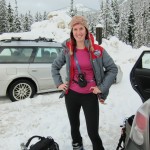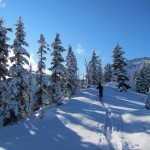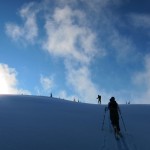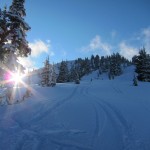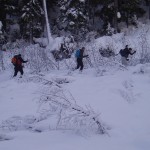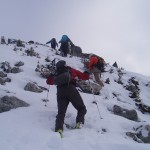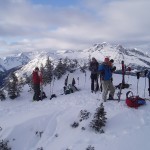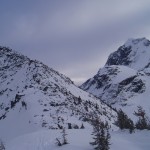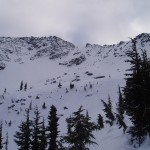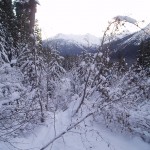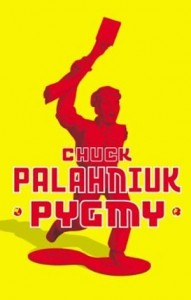Trip Date: Oct 2, 2010
Participants: Max Bitel, David Carne, Jeff Ross, Geoff Zenger (reporter)
Difficulty: 4. Mostly sustained 3rd class with exposure, but with a couple of 4th class steps that many people would want a rope to safely ascend. It is harder than most of the “difficult” scrambles in Matt Gunn’s book, and it is recommended that you complete many of them, or have an outdoor rock climbing background, before attempting this route. If you follow the slabs direct to the summit instead of exiting at the end of the couloir, then there is substantial 4th class on the route.
Report: For this blog’s first trip report, I’ve decided to post a trip report from the vault, so to speak, from one of my favourite scrambles of the past few years. Max and I would return with Saravie and Brittany the following year to repeat the ascent, with some route modifications.
Max and I had talked about climbing the Crater Slabs route on Crown for at least a year prior to our ascent, but each time we had planned on climbing it the weather turned and our trip had to be cancelled. Lucky for us, after a miserable September, early October brought a few days of sun to dry out the slabs so we quickly arranged to attempt the route.
I awoke Saturday morning to a grey sky of low overcast and a call from David to inform me that my ride to the base of Grouse would be late. David, Max, and I ended up not arriving at the base of the grind until nearly 8:30, by which point Jeff had been waiting for us for a full half hour. We were unsure of whether it would be better to approach the crater slabs from Lynn / Hanes valley or from Grouse, but we decided on the Grouse approach after a friend told us that a couple weeks earlier he had some difficulties crossing Lynn creek. Another concern was that although the day was forecast to be dry and it had been dry all week in the city, online satellite precipitation maps showed that it had been raining lightly during the night in the vicinity of Crown mountain. It would turn out that there is little foliage in the couloir or on the slabs, and so although the forest was wet, by mid-day the rock was bone dry.

Upon seeing the crowds at the base of the grind and the BCMC trail and figuring that we had no reason to rush, we started up the grind and headed for one of the trails that leads directly up to Dam mountain in order to avoid the crowds. We reached the peak of Dam around 11:15 and took a break to eat lunch. Soon after beginning the descent from Dam to Crown pass, we encountered a group of German hikers who thought that there were bears on the ridge to Goat, and we were advised to not proceed. Not seeing any signs of bears, we ignored their advice and proceeded down to Crown pass and into Hanes valley. As we began the descent, the clouds finally cleared and gave way to sun, leaving us with perfect scrambling conditions.
While descending into Hanes valley it looked like it might be possible to avoid descending all the way down until the talus slope that descends from Crown pass intersects the one coming down the valley from the summit of Crown by traversing the slopes at the base of the rock wall on the left. Not sure of whether the traverse was feasible or not, Jeff, Max, and I sat down as David went on a scouting mission to investigate. Some ten minutes later we could hear the words “go down” echo through the valley and we got up to head down to where the two talus slopes intersected. Not knowing what happened to David and apparently no longer in vocal communication range with him, we waited at the bottom for him, and were finally ready to begin our ascent of Crown from deep in Hanes valley at about 1:30.
To reach the Crater Slabs, you ascend the slope from Hanes valley leading towards the summit of Crown, always following the left-hand wall. After 20 or so minutes of ascending from the valley bottom, we reached the beginning of the Crater Slabs route proper, where the route starts up a narrow rock gully with a small creek running through it. Until this point, the route is a straightforward hike, but from this point onwards the route steepens significantly, and although the gully is mostly 3rd class, there are a number of class 4 sections that many people would be uncomfortable ascending without a belay (especially when wet). The rock is generally of good quality, although friable in places. The most difficult step of the gulley is right at its end, where there is a short near-vertical wall that needs to be ascended to reach the main slabs. Once the slabs are reached, downclimbing the route to retreat would be significantly more difficult than continuing upwards.

Our original intent had been to follow the main couloir most of the way up, and to traverse right out of the couloir onto a bushy ledge, and to ascend from there straight up to the summit of Crown. However, we missed our turn off from the main couloir, and ascended it all the way to the top, where it connects with the regular Crown hiking trail about a hundred feet below the summit. This is fairly easy, although near the top there is a lot of loose rock, including some larger boulders. Our only scare of the day happened when a large boulder was sent down the couloir and sent an avalanche of rocks down the gully between where Max and I were climbing. Another feasible option would be to traverse out of the main couloir to the lower angle slabs below the Camel and to approach the summit of Crown from the base of the Camel. All of these variations are quite similar in exposure and angle, and any one will provide for a great day of scrambling. From the base of the gully at the top of Hanes Valley to the summit of Crown via the Crater Slabs took about an hour and a half.

We reached the top of Crown sometime between 3:15 and 3:30, where we found sizeable crowd of hikers eager to learn about the route that they had watched us ascend. We left the summit around 4:30 and hiked down to the gondola in beautiful light and cool, crisp autumn air, arriving at the chalet just as the sun set, a bit before 7pm. With its long line of enjoyable scrambling and its proximity to the city, this route is highly recommended.
Verdict: 3/3. A must do for the experienced coastal scrambler

